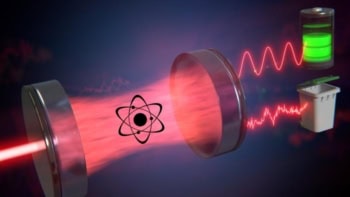
A collaboration of particle physicists in Europe and North America have calculated the mass of strange quarks to an accuracy of better than 2%, beating previous results by a factor of 10. The result will help experimentalists to scrutinize the Standard Model of particle physics at accelerators such as CERN’s Large Hadron Collider and Fermilab’s Tevatron.
Quarks are elementary particles possessing familiar properties such as mass and charge, but they never exist as free particles. Instead they join together by the strong force into bound states called hadrons, which include the proton and the neutron. Theorists predict that a large portion of the hadron mass is accounted for by the strong force, mediated by particles known as gluons, and the exact nature of these interactions are still poorly understood.
Quark colour
To determine the mass of individual quarks, therefore, theorists have to combine experimental measurements of hadrons with calculations based on quantum chromodynamics (QCD) – the theory of the strong force. Refinements to this theory over the years have enabled experimentalists to calculate the mass of the heavier three quarks – the top, bottom and charm – to an accuracy of 1%. Unfortunately, however, it is has been much harder to make accurate predictions for the mass of the three lighter quarks – the up, down and strange – and reference tables still contain errors of up to 30%.
Christine Davies at the University of Glasgow and her colleagues in the High Precision QCD collaboration have now finally produced an accurate figure for the mass of the strange quark by taking a different, mathematical approach. They have used a technique known as “lattice QCD”, where quarks are defined as the sites of a lattice and their interaction via gluons represented on the connecting links.
Lattice QCD, which requires the use of powerful supercomputers, enabled the researchers to measure the ratio of the charm quark to the strange quark to an accuracy of 1%. Since the mass of the charm quark is well defined, Davies calculates that the strange quark has a mass of 92.4 MeV/c2 plus or minus 2.5 MeV/c2.
Precision programme
This result is part of a programme of precision calculations in lattice QCD that will help experimentalists at accelerators like the LHC to make sense of the collisions they observe. They are of particular interest to researchers at the LHCb experiment who, by studying mesons made of bottom quarks, are trying to understand whether current physics can describe how our universe developed,
Indeed, many particle physicists believe that once the LHC is ramped up to 14 TeV it will be in a position to either confirm or destroy the Standard Model of particle physics. “This is all part of pinning down the Standard Model and asking how nature can tell the difference between matter and antimatter,” says Christine Davies. In the short term, the High Precision QCD team intends to develop its research by using the same method for bottom quarks, to get accurate results for its mass and the decay rates of its hadrons needed by LHCb.
David Evans, a researcher at the University of Birmingham and a member of the ALICE experiment at CERN, says that it is important to know quark masses for the pursuit of new physics. “If you want to predict new particles in higher energy states, it is very important to know the mass of its constituent parts,” he says. “As far as I know, this is the only group to pin down the mass of light quarks to such high accuracy”.
This research is published in Physical Review Letters.



